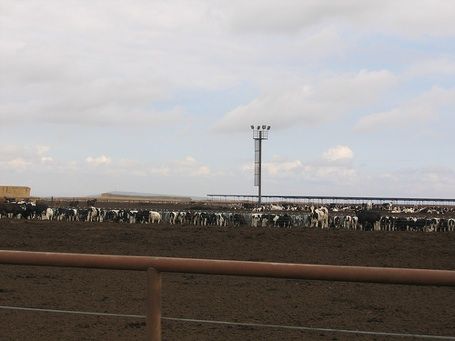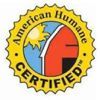As our group approached, the pig rose up on her hind legs, placed her front legs on the ledge of her pen, and looked us all straight in the eyes with a completely charming mixture of intelligence and humor. Without a doubt, that pig was posing. The pen was small, but clean. The pig appeared to have plenty of freedom of movement. The pig was whole, no cropped tail, no sores, nothing amiss. I can't pretend to know if that pig was a happy pig. But from my limited human perspective, she looked contented.
Every time I think about how we raise animals for food, I think about that expressive pig. That pig represents both my deep ambivalence about eating animals and also what I think of as the ideal way to raise animals for food.
For those of us who do eat meat, who don't raise our own animals, one at a time, or who cannot afford to pay top dollar to buy direct from a very small farm, that ideal is pretty near unattainable.
For conscious omnivores, who eat meat sparingly and thoughtfully, who avoid meat raised under conditions that we call "factory farming," what is a reasonable level of animal welfare in farming? And how accurate are our perceptions of what constitutes "good farming"? Farming is a struggle for farmers. There is a delicate balance between the scale and methods that will allow the farmer to stay in business and earn a living, and letting the animals experience life as naturally as possible.
So what does humane treatment of animals actually look like? Who defines it? And most important, if you're a meat eater, what is your personal line?
The Humane Society of the United States has been actively documenting the worst abuses of factory farming in a series of undercover investigations. In December, a video showing atrocities at a Smithfield pig breeding facility in Virginia was released. The pigs were kept in gestation crates barely large enough for their bodies for their entire lives, live pigs were thrown in dumpsters, and baby piglets were left to die in manure pits after falling through the slats of the crates that their mothers spent their entire lives in.
Just in time for Thanksgiving, a video documenting the routine mutilation of turkey poults at the nation's largest turkey hatching facility was released. Fifty percent of the turkeys available in typical grocery stores came from that particular hatchery.
How can you be sure that you are not contributing to such practices? Find out what humane treatment is, study the certifications, and then buy meat that you can feel good about.
At a glance, here are the various certifications, their affiliations, and their logos:
All these standards are summarized here. Download the pdf chart to see a chart of side-by-side comparisons.
It's a complex issue so here's my take on it:
Best of the Best:
If you have plenty of money and access to small farms, go for the strictest certification, which in most cases is Animal Welfare Approved. This certification seems to cover mostly very small family farms. Some of the small family farms from which you buy might more than meet the requirements, but they also might know their customers well enough that they don't become certified. The lesson here is to know your farmer and visit the farm, if you can. In which case, the certification doesn't even matter.
Next Best:
Humane Farm Animal Care does a great job of writing standards for operations of different sizes and scales. Some of the commonly available mid-sized regional producers are able to meet these standards, so if you buy your food in a grocery store, not direct from farmers, this is the best certification to look for.
The Rest:
Global Animal Partnership has some good standards on important issues, but doesn't address a lot of issues that need addressing. If Whole Foods is your store, you can see where they are headed with their certification system that rates producers according to a series of steps.
USDA Organic is better than nothing but doesn't impose many restrictions on how the animals are treated other than those relating to feed, antibiotics, and hormones.
American Humane Certified is the weakest because it isn't transparent and doesn't address many issues. Plus, it allows a lot of common practices none of the others do.
In the end, you have to decide what your personal limits are - both budgetary and ethically.
Summary of Major Requirements Per Species by Certification
Chickens:
Growth Hormones - prohibited by all except not addressed by American Humane Certified
Antibiotics - prohibited by all except allowed by American Humane Certified
Outdoor access - minimum access required by USDA Organic, pasture required by Animal Welfare Approved, not required by other certifications. When provided, there are specific requirements laid out by Humane Farm Animal Care
Space - 6 lb. per square foot required by Humane Farm Animal Care, .67 square foot per bird for roosting, plus range space required by Animal Welfare Approved, 6.2 lb. per square foot required by American Humane Certified, no space requirements from other certifications.
Required dark periods for sleep - 6 to 8 hours required by all except no requirements by USDA Organic or Global Animal Partnership
Beak and toe clipping - Prohibited by Humane Farm Animal Care, Animal Welfare Approved, and Global Animal Partnership, unclear whether allowed by others.
Pigs:
Growth Hormones - Prohibited by all except allowed by American Humane Certified
Antibiotics - Prohibited by all except allowed by American Humane Certified for disease treatment only
Outdoor Access - Pasture required by Animal Welfare Approved, access required by USDA Organic, not required by Global Animal Partnership or American Humane Certified, standards for both indoor and outdoor care by Humane Farm Animal Care
Tail Docking - not allowed by Humane Farm Animal Care, Animal Welfare Approved, Global Animal Partnership, allowed by USDA Organic and American Humane Certified
Cows
Growth Hormones - Prohibited by all except allowed by American Humane Certified
Antibiotics - Prohibited by all except allowed by American Humane Certified
Pasture Range Requirements - Pasture raising and finishing required by Animal Welfare Approved, Feedlot and grass allowed by Global Animal Partnership and USDA Organic (minimum pasture requirement), standards for both pasture and grass written by Humane Farm Animal Care, (feedlots allowed) no requirements by American Humane Certified.









Reader Comments
to our Newsletter